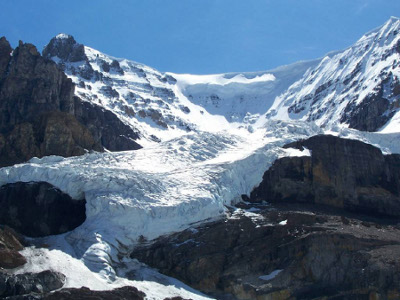Rockies Glaciology and Climatology
Glaciers are perennial ice masses that are large enough to experience flow. Gravitationally driven ice motion occurs through three different mechanisms:
- Internal ‘creep’ deformation
- Sliding along the ice‐bed interface
- Deformation of subglacial sediments
All three processes are believed to be active in the Canadian Rockies, though there are few studies of glacier dynamics in the Rockies. Where they have been measured, typical flow rates are on the order of tens of metres per year (eg: 30 meters per year, near the snow‐coach turnaround on the Athabasca Glacier; Paterson, 1964). Small cirque glaciers will move at just a few meters per year.
 |
|
Athabasca Glacier |
While there is good information about the number and area of glaciers in the Rockies, little is known about ice thickness or volume. Ice thickness estimates require time‐ and labour‐intensive ice radar surveys, executed through the towing of an ice radar or low frequency ground‐penetrating radar (GPR) system along the glacier surface, or airborne radar surveys.
Temperatures in the Canadian Rockies
Glaciers of the Rockies are ‘isothermal’ – they are at the melting point throughout their depth. There is no simple ‘threshold temperature’ for a glacier to be viable. A mean annual temperature below 0°C is not a necessary or sufficient condition for glacier ice to exist.
Read about Temperatures in the Canadian Rockies
Glacier Mass Balance
Glacier mass balance refers to the change in mass of a glacier over a specific time frame, typically one year. Glaciers of the Rockies typically accumulate snow from mid-September through mid-May (the ‘accumulation season’) and experience melting and runoff from mid-May through mid-September (the ‘melt season’). Mass balance can be estimated through remote sensing techniques such as repeat airborne or satellite laser altimetry, which can measure changes in surface elevation.
Read about Glacier Mass Balance
Download
Alberta Glacier Inventory and Ice Volume Estimation (3.49 MB)
